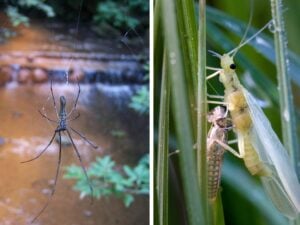Forest, stream habitats keep energy exchanges in balance, global team of researchers finds – Outdoor News
University Park, Pa. — Forests and streams are separate but linked ecosystems, existing side by side, with energy and nutrients crossing their porous borders and flowing back and forth between them.
For example, leaves fall from trees, enter streams, decay and feed aquatic insects. Those insects emerge from the waters and are eaten by birds and bats. An international team led by Penn State researchers has now found that these ecosystems appear to keep the energy exchanges in balance — a finding that the scientists called surprising.

Scientists around the world who have conducted research on the exchange of energy, materials and organisms between these connected ecosystems have come to call the phenomenon “allochthony” — meaning the consumption of resources by organisms residing in one ecosystem, when that energy was produced in another ecosystem.
The balance between aquatic and terrestrial ecosystems has been difficult to gauge and poorly understood at a global scale because it depends on an uneven flow of energy and nutrients that fluctuates across seasons and across different climates.
MORE COVERAGE FROM OUTDOOR NEWS:
Groups file lawsuit to halt power line across Mississippi River Wildlife Refuge
Pennsylvania’s West Branch Susquehanna Watershed now has wild trout after water quality improvements
Upper Mississippi River Refuge set to celebrate 100 years
But findings of a new study recently published in Ecology Letters sheds new light on the relationship between forests and streams. The researchers, who analyzed data from 149 studies of coupled forest-stream ecosystems around the world, found that aquatic and terrestrial organisms consume the same amount of energy that comes from the opposite ecosystem.

“This was a really interesting and unexpected result because we know that there’s way more energy flowing into streams in the form of leaves that fall from trees than what comes out in the form of emergent aquatic insects,” said the study’s lead author Daniel Allen, assistant professor of aquatic ecology, Penn State College of Agricultural Sciences. “But the quality of the resources is vastly different, because the aquatic insects that emerge from streams are very nutritious.”

The researchers also found that consumer allochthony varies with feeding traits for aquatic invertebrates, fish and terrestrial arthropods — such as insects, beetles and spiders — but not for terrestrial vertebrates such as birds and rodents. Finally, they reported that allochthony is nearly twice as great in arid climates than tropical ones for aquatic invertebrates, but remains steady for fish across varied climates.
“Most people don’t think about streams and forests being interrelated, but the organisms those habitats support are dependent on energy and resources that come from outside their ecosystem,” Allen said. “This phenomenon is true around the world, and this study is important because we collected data across the planet, to look at how this fundamental process varies in different climates, seasons and from over 700 different stream and riparian species.”

Contributing to the research at Penn State were postdoctoral scholar Veronica Saenz, graduate student Kierstyn Higgins and recently graduated master’s degree student Alice Belskis, all in ecosystem science and management. Also contributing to the research were: James Larson, U.S. Geological Survey, Upper Midwest Environmental Sciences Center; Christina Murphy, U.S. Geological Survey, Maine Cooperative Fish and Wildlife Research Unit; Erica Garcia, Charles Darwin University, Australia; Kurt Anderson, University of California, Riverside; Michelle Busch, University of Kansas; Alba Argerich, University of Missouri; Brooke Penaluna, PNW Research Station, U.S. Forest Service; Jay Jones, University of Alaska, Fairbanks; and Matt Whiles, University of Florida.
The U.S. National Science Foundation supported this research.






